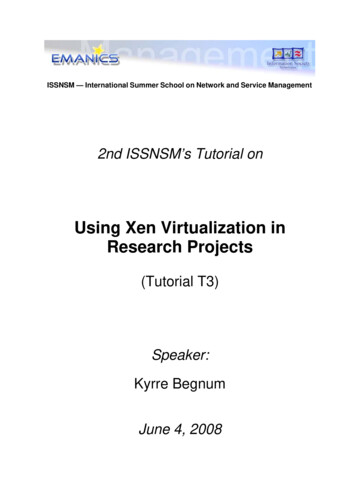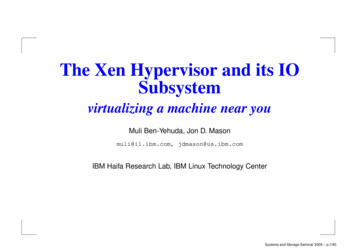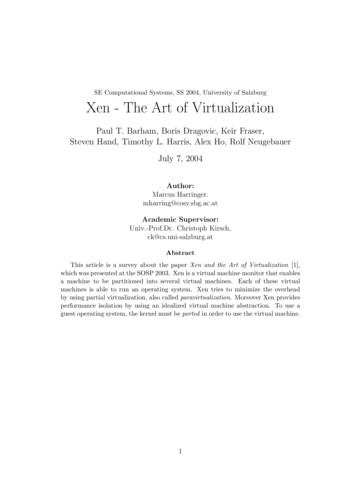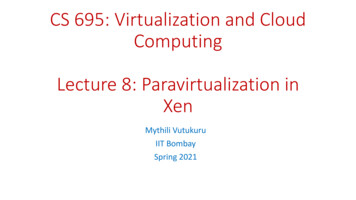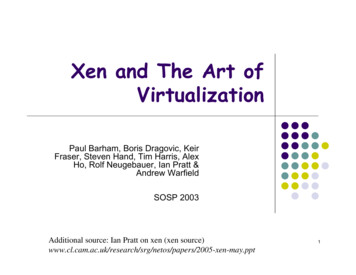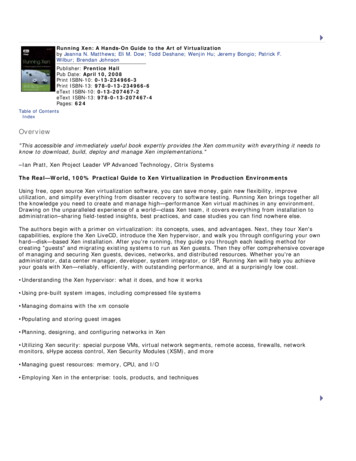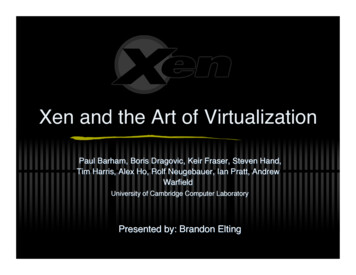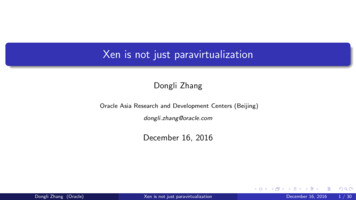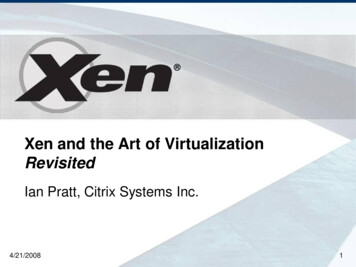
Transcription
Xen and the Art of VirtualizationRevisitedIan Pratt, Citrix Systems Inc.4/21/20081
Outline A brief history of XenWhy virtualization mattersParavirtualization reviewHardware-software co-design– MMU virtualization– Network interface virtualization4/21/20082
The Xen Story Mar 1999 XenoServers HotOS paperApr 2002 Xen hypervisor development startsOct 2003 Xen SOSP paperApr 2004 Xen 1.0 releasedJun 2004 First Xen developer‟s summitNov 2004 Xen 2.0 released2004 Hardware vendors start taking Xen seriously2005 RedHat, Novell, Sun and others adopt Xen2006 VMware and Microsoft adopt paravirtualizationSep 2006 First XenEnterprise releasedMay 2008 Xen embedded in Flash on HP/Dell servers4/21/20083
Xen Project Mission Build the industry standard open sourcehypervisor– Core "engine" that is incorporated into multiple vendors‟ products Maintain Xen‟s industry-leading performance– Be first to exploit new hardware acceleration features– Help OS vendors paravirtualize their OSes Maintain Xen‟s reputation for stability and quality– Security must now be paramount Support multiple CPU types; big and smallsystems– From server to client to mobile phone Foster innovation Drive interoperability
Why Virtualization is „Hot‟ Clearing up the mess created by the success of„scale-out‟– One Application per commodity x86 server– Leads to „server sprawl‟– 5-15% CPU utilization typical Failure of popular OSes to provide––––4/21/2008Full configuration isolationTemporal isolation for performance predictabilityStrong spatial isolation for security and reliabilityTrue backward app compatibility5
First Virtualization Benefits Server consolidation– Consolidate scale-out success– Exploit multi-core CPUs Manageability– Secure remote console– Reboot / power control– Performance monitoring Ease of deployment– Rapid provisioning VM image portability– Move image between different hardware– Disaster Recovery6
2nd Generation Virtualization BenefitsAvoid planned downtime with VMRelocationDynamically re-balance workloadto meet application SLAsHardware Fault Tolerance withreplay / checkpointing7
Hypervisor Security “hidden hypervisor” attack is a myth, butexploitation of an installed hypervisor is a realand dangerous threat Hypervisors add more software and thusincrease the attack surface– Network-facing control stack– VM containment Hopefully much smaller and defensible than aconventional OS– Need a “strength in depth” approach– Measured launch8
Improving Security with Hypervisors Hypervisors allow administrative policyenforcement from outside of the OS– Firewalls, IDS, malware scanning etc More robust as not so easily disabled Provides protection within a network rather than just atborders– Hardening OSes with immutable memory, tainttracking, logging and replay– Backup policy, multi-path IO, HA, FT etc Availability and Reliability Reducing human effort required to admin all theVMs is the next frontier4/21/20089
Breaking the bond between OS and h/w Simplifies Application-stack certification– Certify App-on-OS; OS-on-HV; HV-on-h/w– Enables Virtual Appliances Virtual hardware greatly reduces the effortto modify/create new OSes– Application-specific OSes Slimming down and optimization of existing OSes “Native execution” of Apps Hypervisors enable h/w vendors to „lightup‟ new features more rapidly4/21/200810
Paravirtualization Extending the OS to be aware it is running in avirtualized environment– For performance and enhanced correctness– IO, memory size, CPU, MMU, time In Xen 2.0, some paravirtulizations werecompulsory to close x86 virtualization holes– Intel VT / AMD-V allow incremental paravirtualization Paravirtualization is still very important forperformance, and works along sideenhancements to the hardware– Higher-level paravirtualizations yield greatest benefit4/21/200811
MMU Virtualization Critical for performance, challenging tomake fast, especially SMP– Hot-unplug unnecessary virtual CPUs– Use multicast TLB flush paravirtualizations etc Xen supports 3 MMU virtualization modes1.Direct pagetables2.Shadow pagetables3.Hardware Assisted Paging OS Paravirtualization compulsory for #1,optional (and very beneficial) for #2&34/21/200812
MMU Virtualization : Direct-Modeguest readsVirtual Machineguest writes(typically batched)Guest OSXen VMMMMUHardware Requires guest changes– Supported by Linux, Solaris, FreeBSD, NetBSD etc Highest performance, fewest traps
Shadow Pagetablesguest readsVirtual Guest-physicalguest writesAccessed &dirty bitsGuest OSUpdatesVirtual MachineVMMMMUHardware Guest changes optional, but help with batching,knowing when to unshadow Latest algorithms work remarkably well
Peformance4/21/200815
Hardware Assisted Paging AMD NPT / Intel EPT Hardware handles translation with nested pagetables– guest PTs managed by guest in normal way– guest-physical to machine-physical tables managed by Xen Can increases the number of memory accesses toperform a TLB fill pagetable walk by factor of 5 (gulp!)– Hopefully less through caching partial walks– But reduces the effective TLB size Current implementations seem to do rather worse thanshadow PTs (e.g. 15%)– Wide-SMP guests do relatively better due to no s/w locking TLB flush paravirtualizations essential– H/w will improve: TLBs will get bigger, caching more elaborate,prefetch more aggressive4/21/200816
Network Interface Virtualization Network IO is tough– High packet rate Batches often small– Data must typically be copied to VM on RX– Some apps latency sensitive Xen‟s network IO virtualization hasevolved over time– Take advantage of new NIC features– Smart NIC categorization: Types 0-34/21/200817
Level 0 : Modern conventional NICs Single free buffer, RX and TX queuesTX and RX checksum offloadTransmit Segmentation Offload (TSO)Large Receive Offload (LRO)Adaptive interrupt throttlingMSI support (iSCSI initiator offload – export blocks to guests) (RDMA offload – helps live relocation)
I/O ArchitectureVM0VM1VM2VM3DeviceManager &Control tOSGuestOSGuestOSFront-EndDevice DriversFront-EndDevice DriversBack-EndNativeDeviceDriverControl IFSafe HW IFEvent ChannelVirtual CPUDeviceEmulationVirtual MMUXen Virtual Machine MonitorHardware (SMP, MMU, physical memory, Ethernet, SCSI/IDE)
Direct Device AssignmentVM0VM1VM2VM3DeviceManager &Control tOSGuestOSGuestOSBack-EndNativeDeviceDriverControl IFNativeDeviceDriverSafe HW IFFront-EndDevice DriversEvent ChannelVirtual CPUDeviceEmulationVirtual MMUXen Virtual Machine MonitorHardware (SMP, MMU, physical memory, Ethernet, SCSI/IDE)
Xen3 Driver DomainsVM0VM1DeviceManager &Control rControl IFNativeDeviceDriverSafe HW t-EndDevice DriversEvent ChannelVirtual CPUDeviceEmulationVirtual MMUXen Virtual Machine MonitorHardware (SMP, MMU, physical memory, Ethernet, SCSI/IDE)
Grant Tables Allows pages to beshared betweendomains No hypercall neededby granting domain Grant map,Grant copy andGrant transferoperations Signalling via eventchannelsHigh-performance secure inter-domain communication
Level 1 : Multiple RX Queues NIC supports multiple free and RX buffer Q‟s– Choose Q based on dest MAC, VLAN– Default queue used for mcast/broadcast Great opportunity for avoiding data copy forhigh-throughput VMs– Try to allocate free buffers from buffers the guestis offering– Still need to worry about bcast, inter-domain etc Multiple TX queues with traffic shapping
Level 2 : Direct guest access NIC allows Q pairs to be mapped intoguest in a safe and protected manner– Unprivileged h/w driver in guest– Direct h/w access for most TX/RX operations– Still need to use s/w path for bcast, inter-dom Memory pre-registration with NIC viaprivileged part of driver (e.g. in dom0)– Or rely on architectural IOMMU in future For TX, require traffic shaping and basicMAC/srcIP filtering enforcement
Level 2 NICs e.g. Solarflare / Infiniband Accelerated routes set up by Dom0– Then DomU can access hardware directly Allow untrusted entities to access the NICwithout compromising system integrity– Grant tables used to pin pages for DMA Treated as an “accelerator module” to alloweasy hot omUHypervisorHardware
Level 3 Full Switch on NIC / MR-IOV NIC presents itself as multiple PCIdevices, one per guest– Relies on IOMMU for protection– Still need to deal with the case when there aremore VMs than virtual h/w NIC– Worse issue with h/w-specific driver in guest Full L2 switch functionality on NIC– Inter-domain traffic can go via NIC But goes over PCIe bus twice
Performance Default configuration (6 pkt/intr)Interrupt throttling config (64 pkt/intr)35CPU (%)25193%20126%15100%CPU Type-0Type-1Type-2linux Smarter NICs reduce CPU overhead substantially Care must be taken with type-2/3 NICs to ensurebenefits of VM portability and live relocation are not lost “Extreme late copy” for zero-copy inter-domaincommunication under developmentpage 27April 21, 200
Conclusions Open Source is a great way to get impactfrom University research projects Hypervisors will become ubiquitous, nearzero overhead, built in to platform Virtualization may enable a new "goldenage" of operating system diversity Virtualization is a really fun area to beworking in!ian.pratt@xen.org4/21/200828
Xen and the Art of Virtualization Revisited Ian Pratt, Citrix Systems Inc. 4/21/2008 1. Outline A brief history of Xen Why virtualization matters Paravirtualization review Hardware-software co-design -MMU virtualization -Network interface virtualization 4/21/2008 2.


